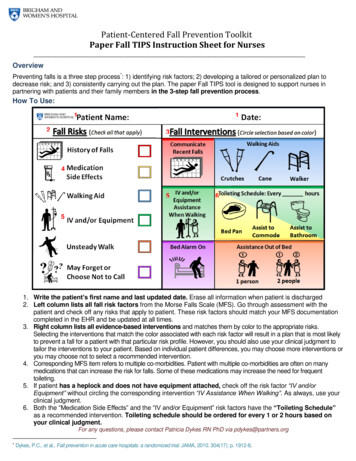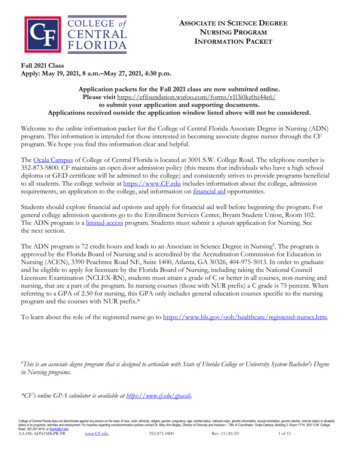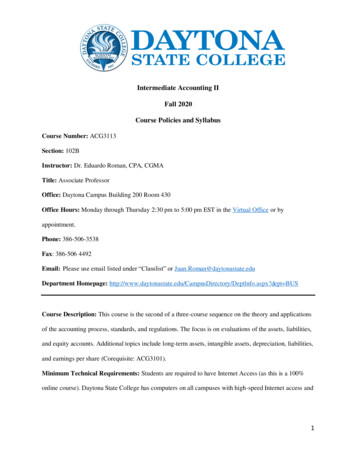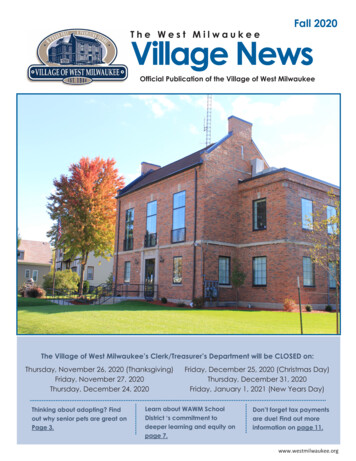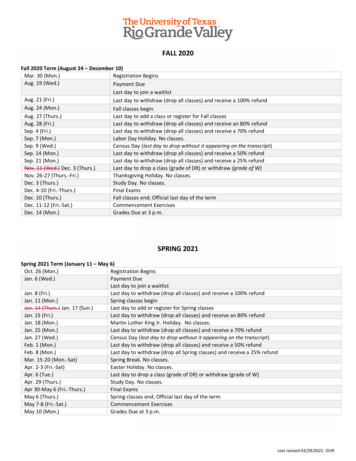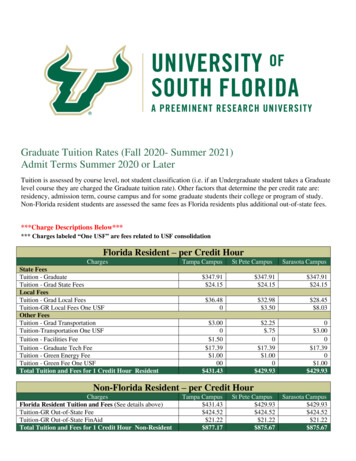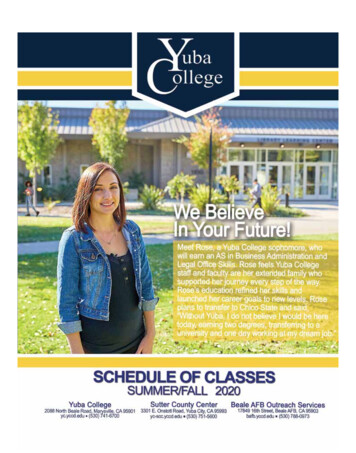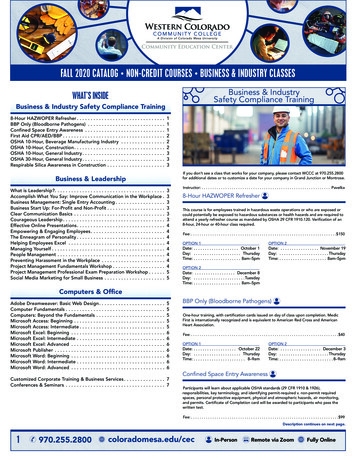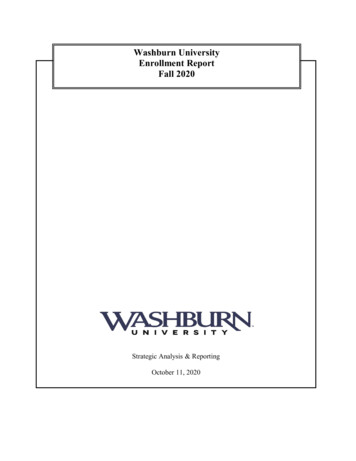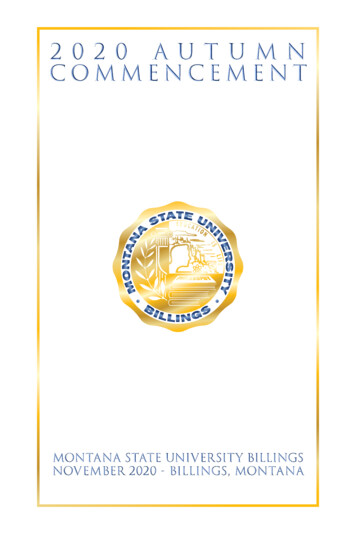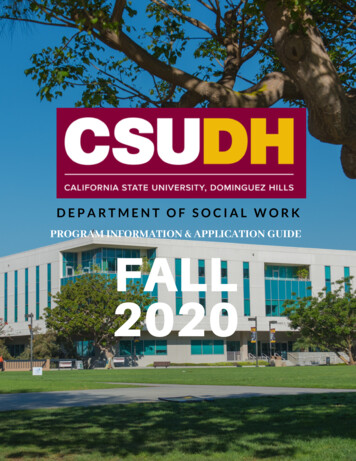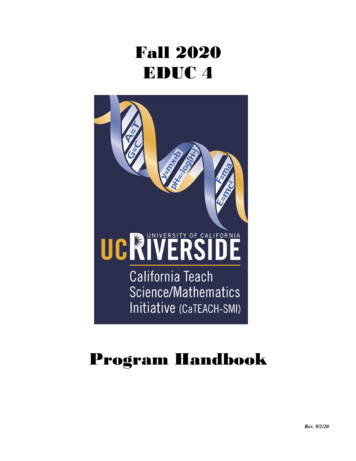
Transcription
Fall 2020EDUC 4Program HandbookRev. 9/2/20
TABLE OF CONTENTSI.General References ··················3A. Contact InformationB. Pathways to Preparing Quality Science and Mathematics TeachersII.Mentees ········ 6A.B.C.D.General Expectations: Classroom Code of Conduct and Professional ValuesCourse Preparation TimelineMentees’ Responsibility ChecklistSMI Classroom Supply Reimbursement Procedures and GuidelinesIII. Documentation of Hours (DOH) Form ····················· 11IV. Financial Resources ·················· 13A.B.C.SMI Exam & Professional Development Reimbursement ProgramSupply Request for Classroom Project:a. Approval Formb. Reimbursement FormSMI Tiered Scholarship ProgramUCR Fall 2020 ACADEMIC CALENDARSeptember 28, 2020October 1, 2020November 10, 2020November 26-27, 2020Instruction EndsDecember 11, 2020Final ExaminationsDecember 12-18, 2020For Mentor Teachers:December 14, 2020Quarter BeginsInstruction BeginsHolidaysQuarterly Progress Reports Due2
SECTION IGeneral References3
CONTACT INFORMATIONKaren Withey-SmithEDUC 4 Instructor Assigns and evaluates all course assignments including weekly journal reflections Monitors Fieldwork hours Issues course gradesLeslie BushongStaff Director Oversees course program developmentDetermines school placement assignmentRecruits and advises pre-service STEM teachersAuthorizes travel reimbursement requests and stipends Professor Estela GavostoProfessor Cathy LussierFaculty Directors Website:Location:E-mail:Oversees program developmentRecruits and advises pre-service STEM teachersReviews petitions for course gradeshttp://smi.ucr.edu1114 Pierce Hallsmi@ucr.edu4
CalTeach-SMIPathways to Teacher Credential ProgramsStarting as Freshman/SophomoreStarting as UCR Upperclassman/Junior TransferEDUC 003Peer Mentor ProgramEDUC 003YEAR 1EDUC 4-NASC 192/192LCBEST Testing*Upper DivisionEDUC CoursesEDUC 004Peer Mentor ProgramCBEST/CSET Testing*2Peer Mentor ProgramCBEST/CSETTesting*2YEAR 2Classroom Fieldwork Scholarships*2NASC 192/192LTeacher Apprentice ProgramUpper DivisionEDUC CoursesCBEST/CSETTesting*2,3Classroom Fieldwork Scholarships*2,3YEARS3&4Teaching Credential Program**1(30 hours of field work requiredfor some programs)Teacher Apprentice ProgramTeaching Credential Program**1(Optional: Intern Teacher Status 120 hourscoursework/fieldwork)Scholarships: Exam and Professional Reimbursements)3 Tier III Scholarships (up to 4,000)2 Tier II Scholarships (up to 5,000)1 Tier I Scholarships (up to 8,000)* SMI Financial Resources–more details on https://smi.ucr.edu**Refer to specific teacher credential programs’ admissions criteria for more details.
SECTION IIMentees6
General Expectations:Classroom Code of Conductand Professional ValuesAll Mentees are expected to: Act as professional representatives of UCR. Dress in professional and conservative attire when working at their school site.Suitable Articles of Clothing:Women: Slacks (dress pants), skirts (mid-calf to about two inches above the knee), blouses, blazers,casual dresses, closed toed shoes.Men: Slacks (dress pants), button down shirts, polo shirts (short sleeved shirts with a collar), blazers,closed toed shoes. Be punctual and prepared to observe and participate. Coordinate your weekly field experience hours with your assigned mentor teacher. Maintain regular communication with assigned mentor teacher. Be respectful of the teacher as s/he is teaching NEVER interrupt during a lessoneven if you think it’s a really important question ask it later! Be addressed as Mr., Miss, Mrs., or Ms. by classroom students.7
COURSE PREPARATION TIMELINEFALL 2020 ONLYBefore Instruction Begins: Download Program Handbook from iLearn and bring (either hard copy or digital print) to first day of classmeeting. Obtain Field (classroom) Placement Information - Refer to “Course Materials” in iLearn. Make arrangements with your assigned Mentor Teacher to establish classroom visitation schedule to begin nolater than 2nd week of the quarter.During Academic Quarter: Adhere to General Expectations: Classroom Code of Conduct and Professional Values.Attend EDUC 4 weekly class and adhere to requirements as described in course syllabus.Complete and document field work requirements:MODIFIED to adapt to school districts’ responses to COVID-19 5 purpose driven check-in interactions with mentor teacher. Each purpose driven could result in multiplevirtual exchanges to simulate natural interactions. Coordinate with assigned SMI Mentor (classroom)Teacher to set up these virtual check-in sessions. Virtual check-in methods may include one or more of these formats: Teleconferencing (Zoom, GoogleMeet, Skype, FaceTime, etc.) Email Phone calls Samples of purpose driven topics -- not restricted to only these topics, check with EDUC 4 instructorfor clarifications and additional suggestions: Best practices for lesson planning and implementation Strategies for differentiating instruction Instructional resources you are using during Distance Learning (DL) Strategies for effective and meaningful STEM instruction Strategies to increase student engagement, including during DL Ways students/parents have responded and adjusted to DL Document each virtual check-in sessions as described on the Documentation of Hours (DOH) form. 25 hours of activities, assignments, discussions from virtual/taped video classrooms resulting.Assignments will be given by EDUC 4 instructor.Immediately contact SMI Mentor (classroom) Teacher and EDUC 4 instructor if unable to fulfill the weeklyclassroom field work responsibilities.Check weekly on your UCR iLearn (http://ilearn.ucr.edu) account.Complete weekly online Journal Reflections through UCR iLearn account. Writing prompts will be posted oniLearn.Plan ahead if you are teaching a lesson. Refer to the “Forms” section in the handbook for financial assistancein purchasing instructional project(s).9
MENTEE’S RESPONSIBITLIES CHECKLISTThroughout the quarter:Maintain updated records on your Documentation of Hours (DOH) formMaintain consistent communication with assigned mentor teacherAttend to EDUC 4 course responsibilitiesBy 1st Day of ClassBring printed or digital copy of EDUC 4 Handbook (download from iLearn) to class.To be conducted between Weeks 1 and 2Introduce yourself to your assigned mentor teacher. Establish method(s) for communication that is agreeable toboth you and your assigned mentor teacher.By 10th Week of the Quarter: (Deadline: 12/11/20 F)Complete the SMI Student Survey for EDUC 4 (on iLearn)Complete and record at least 20 classroom hours at the assigned placement (exceptions must be pre-approved bySMI – hours are verified by assigned Mentor Teacher) on the Documentation of Hours Form.By Monday of Finals Week: (Deadline: 12/14/20 M)Submit completed Documentation of Hours Form.10
SMI Classroom Supply ReimbursementProcedures and GuidelinesAn excellent way to develop pre-service training in the classrooms is to develop and implementclassroom lessons with mentor teachers. As a way to support your classroom endeavors, SMIoffers a modest reimbursement program to help offset costs associated with implementingclassroom lessons.If you wish to seek financial assistance from SMI toward your lesson implementation (up to 25/lesson), please follow the set of instructions listed below:1. Before implementation of lessonSubmit the “Step 1: APPROVAL FORM” with documents requested in the form to SMIResource Center. Please allow for 5 to 7 days to review your request and for the items tobe purchased/delivered.2. After SMI’s Approval Purchase supplies (if SMI is unable to furnish these specific items) Implement lesson Submit “Step 2: REIMBURSEMENT FORM” with itemized paid receipt of itemsSMI approved for reimbursement. LIST OF UNAPPROVED ITEMSFood or Beverage ItemsExplosives/FirearmsControlled Substances/Narcotics/Dangerous DrugsConsultantsPurchases from University Employees and Near RelativesRadioactive ItemsRental of Real PropertyRepairs to the Plants & Grounds11
SECTION IIIDocumentation of Hours (DOH) Form11
Rev. 8/30/20DateBest practices for lesson planning andimplementationStrategies for differentiating instructionInstructional resources you are usingduring Distance Learning (DL)Strategies for effective and meaningfulSTEM instructionStrategies to increase student engagement,including during DLWays students/parents have respondedand adjusted to DLBest practices for lesson planning andimplementationStrategies for differentiating instructionInstructional resources you are usingduring Distance Learning (DL)Strategies for effective and meaningfulSTEM instructionStrategies to increase student engagement,including during DLWays students/parents have respondedand adjusted to DLTeleconferencingEmailPhone callsIndicate what was the purpose of yourvirtual check-in(check all that apply)Best practices for lesson planning andimplementationStrategies for differentiating instructionInstructional resources you are usingduring Distance Learning (DL)Strategies for effective and meaningfulSTEM instructionStrategies to increase student engagement,including during DLWays students/parents have respondedand adjusted to DLTeleconferencingEmailPhone callsTeleconferencingEmailPhone callsForm of virtualcommunicationBriefly describe and reflect on each field entry-Attach additional paper, if necessary-Attach a pdf copy of email exchanges if virtual check-in was conducted by emailMentor Teacher’s Name School Name School DistrictEDUC 4 – FALL 2020DOCUMENTATION OF HOURS (DOH) FORMVIRTUAL CHECK-IN SESSIONS(DO NOT RECORD ATLAS/VIRTUAL HOURS ON THIS FORM)First and Last Name UCR SID # Subject Content math science
Best practices for lesson planning andimplementationStrategies for differentiating instructionInstructional resources you are usingduring Distance Learning (DL)Strategies for effective and meaningfulSTEM instructionStrategies to increase student engagement,including during DLWays students/parents have respondedand adjusted to DLBest practices for lesson planning andimplementationStrategies for differentiating instructionInstructional resources you are usingduring Distance Learning (DL)Strategies for effective and meaningfulSTEM instructionStrategies to increase student engagement,including during DLWays students/parents have respondedand adjusted to DLTeleconferencingEmailPhone callsIndicate what was the purpose of yourvirtual check-in(check all that apply)Best practices for lesson planning andimplementationStrategies for differentiating instructionInstructional resources you are usingduring Distance Learning (DL)Strategies for effective and meaningfulSTEM instructionStrategies to increase student engagement,including during DLWays students/parents have respondedand adjusted to DLTeleconferencingEmailPhone callsTeleconferencingEmailPhone callsForm of virtualcommunicationBriefly describe and reflect on each field entry-Attach additional paper, if necessary-Attach a pdf copy of email exchanges if virtual check-in was conducted by emailRev. 8/30/20To down load extra copies of Documentation of Hours form, please visit Date
SECTION IVFinancial Resources14
SMI Exam & Professional Development Reimbursement Program(Due to resource and funding limitations, policies, procedure, program availability are subject to changes without advance notice)Funded ActivitiesCBESTExam RegistrationCost Coverage 41Tier 1 ExamReimbursementUp to first CSETmath/science subtests 99/mathUp to second and third CSETmath/science subtests 99/mathOne or more of theseactivities:-Additional CSETmath/science subtests- Professionaldevelopmentworkshops/conferences- Professional affiliationmemberships- Scholarly STEM-EDUCjournals 125/yearEach SMI advisingappointment will bereviewed for eligibility,which will take intoconsideration the SMI ExamTarget Completion Timeline. 30: CBEST 75: CSET Math 100: CSET ScienceTier 2 ExamReimbursementTier 3 Year 133/science Subtest I 134/science Subtest II 133/science Subtest I 134/science Subtest II(approx. 75% of exam fees)One-time Bonus afterfoundation level CBEST have beencompleted: 40 foreach add’lmath/science CSETexam (e.g. MathSubtest III, ScienceSubtest II life sciences,Science Subtest IIchemistry, ScienceSubtest II physics,Science Subtest II earthand space sciences)Requirements Provide passage and payment documentations for Tier 1exam Complete EDUC 3 (minimum C grade) Complete EDUC 4 (minimum C grade) or Complete PeerMentor Program (2 or more terms) Maintain an updated SMI Program Plan Provide passage and payment documentations for Tier 2exam(s) Complete EDUC 3 (minimum C grade) Complete EDUC 4 (minimum C grade) or Complete PeerMentor Program (2 or more terms) Maintain an updated SMI Program Plan Pass CBEST exam (documentation required) Provide passage and payment documentations for Tier 3exam(s) Complete EDUC 3 (minimum C grade) Complete EDUC 4 (minimum C grade) or Complete PeerMentor Program (2 or more terms) Maintain an updated SMI Program Plan Pass CBEST (documentation required) Pass one CSET math/science subtest exam(documentation required) Complete EDUC 3 (minimum C grade) Complete EDUC 4 (minimum C grade) or Complete PeerMentor Program (2 or more terms) Maintain an updated SMI Program Plan Participant of the CMST Apprentice Program or Attend 4TTSM general meetings Pass CBEST (documentation required) Pass 1 CSET math/science subtests (documentationrequired) Minimum GPA of 2.7 Attend PD event in-full Debrief with
Download Program Handbook from iLearn and bring (either hard copy or digital print) to first day of class meeting. Obtain Field (classroom) Placement Information - Refer to “Course Materials” in iLearn. Make arrangements with your assigned Mentor Teacher to establish classroom visitation schedule to begin no later than 2. nd. week of the .

